Kick off the new year by getting the whole family involved in volunteering with the Green Seattle Partnership. It’s a perfect way to connect with your community, get outside, get active, and keep local parks healthy. Many events on the CEDAR volunteer page are open to folks of all ages and is a great opportunity to bring kids along to learn about restoration and become familiar with Seattle’s urban forests. We met with Seattle Parks and Recreation’s Ashley Robles and GSP’s East Duwamish Forest Steward, Gerry Chambers, for tips on bringing kids to events.
Occasionally, events can last several hours. What are some best practices folks can incorporate to prevent burnout and keep kids engaged?
Gerry: At East Duwamish Greenbelt, our work parties are only 2 hours, and I have a total “no guilt” policy. If people need to leave for whatever reason, they are free to come and go. So, if a little one is getting cranky and the parent needs to take them away, that’s fine.
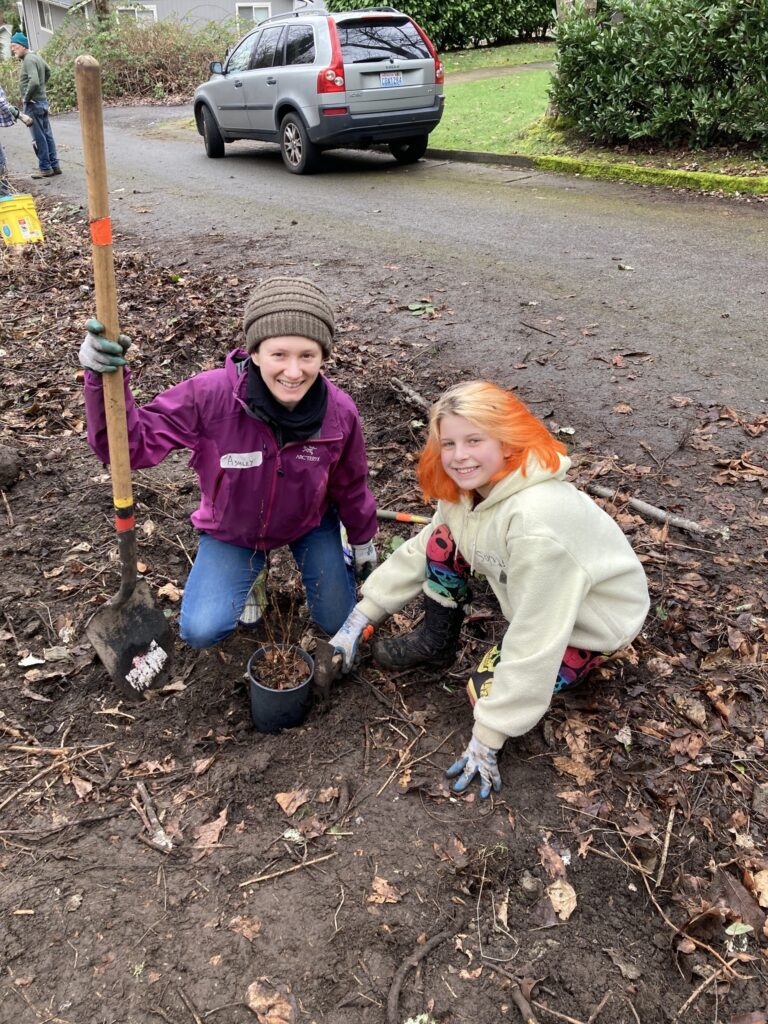
Having said that, I almost never see a kid needing to leave. Astonishingly, a few years ago we had a whole Boy Scout troop from around Greenlake come to our December work party and it rained heavily the whole time. Those kids were just great, and enjoyed the cookies and hot chocolate that we usually have for our December holiday party.
Ashley: It’s always important to keep realistic expectations for yourself, and the kiddos. Check out CEDAR, there are a wide range of events. Whether you are able to stay for one hour or two, or even more, or even less! We appreciate your volunteer time, and interest in the community effort to nurture urban forests. We all understand that families require special patience and encourage you to stay flexible. Remember, as kids grow their endurance to stay longer and help more will grow too. The important thing is positive experiences and memories, so that we can nurture future forest lovers.
Maybe this is something you start doing a few times a year, which then grows to once a month, and even once a week!
It can help to talk about the project ahead of time with children, get conversation going about the work you plan to be doing, and the positive impacts it will have on the environment. Read books that show kids and communities working together on outdoor projects. This will give kids a chance to spark interest and give them contexts to reference once you are all outside together.
What would you recommend folks to bring for kids when attending these events?
Gerry: They might want to bring some snacks for their kids, but otherwise just appropriate clothing. And kids rarely seem to feel the cold as much as adults anyways.
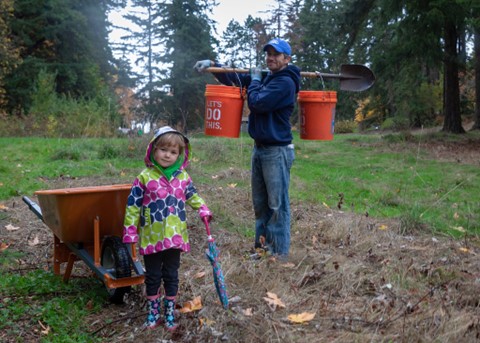
Ashley: Brings snacks. Wear boots. Bring cleaning supplies to wipe mud and encourage kids to get their hands dirty! Depending on the age of children, bring smaller things that may scale the work down for them such as a small play shovel. Find other simple things kids may enjoy if their attention begins to wane. Perhaps they’re done pulling weeds but would still like to play with their toy dinosaurs in the leaves nearby. Or perhaps older children would like to pull out a sketch book and capture a portrait of a local bird, or beautiful tree. Be creative, and don’t be afraid to bring your pack-n-play to the woods!
Some events can include work around thorns and sharp tools, what’s your protocol to prevent injuries?
Gerry: We always require everyone to wear gloves, which we provide, to prevent getting stuck by thorns. It also depends on the age of the kids, sometimes kids just like to take those hand tillers and pound into a rotted log, which I have no problem with. If kids are a little older, they like to build ivy racks and if they can handle the saws, everyone loves to saw. And if the kids are really small, I expect the parents to keep an eye on them.
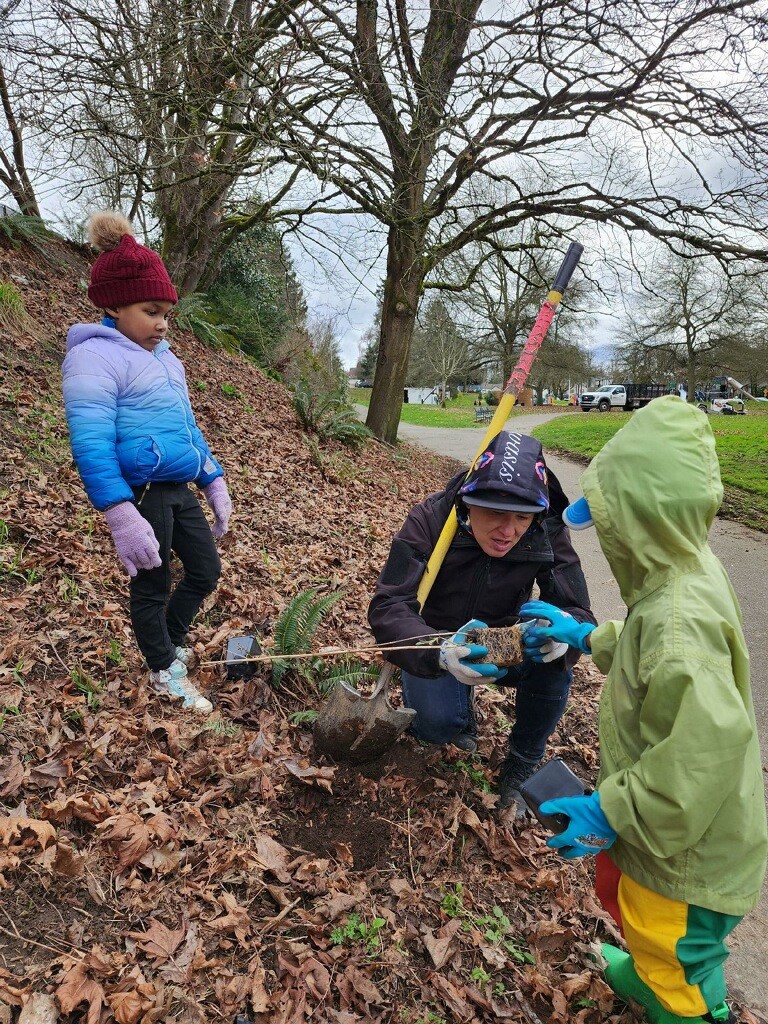
Ashley: We always rely on care-givers to keep a close eye on children, and monitor when kids might be ready for new challenges and learning how to use a new tool. We of course like to keep all tools under safe supervision. And survey the work environment for possible hazards such as thorns or bees! Working in pairs can be a great way to avoid injury, especially when working with kids, a little extra guidance and they quickly pick up the job!
Making sure tools are in good condition, and that gloves and safety eye protection are worn go a long way in preventing injuries in this type of work. We have small buckets, kid’s gloves, and kid’s shovels so check in with your event lead if you want to request these materials in advance of the event.
Seattle is known for rain and cold weather, what are some essential items to bring that can keep kids warm and dry?
Gerry: Good rain gear and enough clothing. Cotton sweatshirts are really not helpful, and fleece is okay, but really the best is wool. If they are really getting into it, a trip to Goodwill for some old wool sweaters is definitely worth it. I do recommend long sleeves and long pants, because my particular greenbelt has A LOT of Stinging Nettle, which can really turn a kid off. Also, good shoes – avoid sandals due to the ground being uneven. And in some areas, you can’t really see where you’re placing your feet because of all the ivy covering the ground.
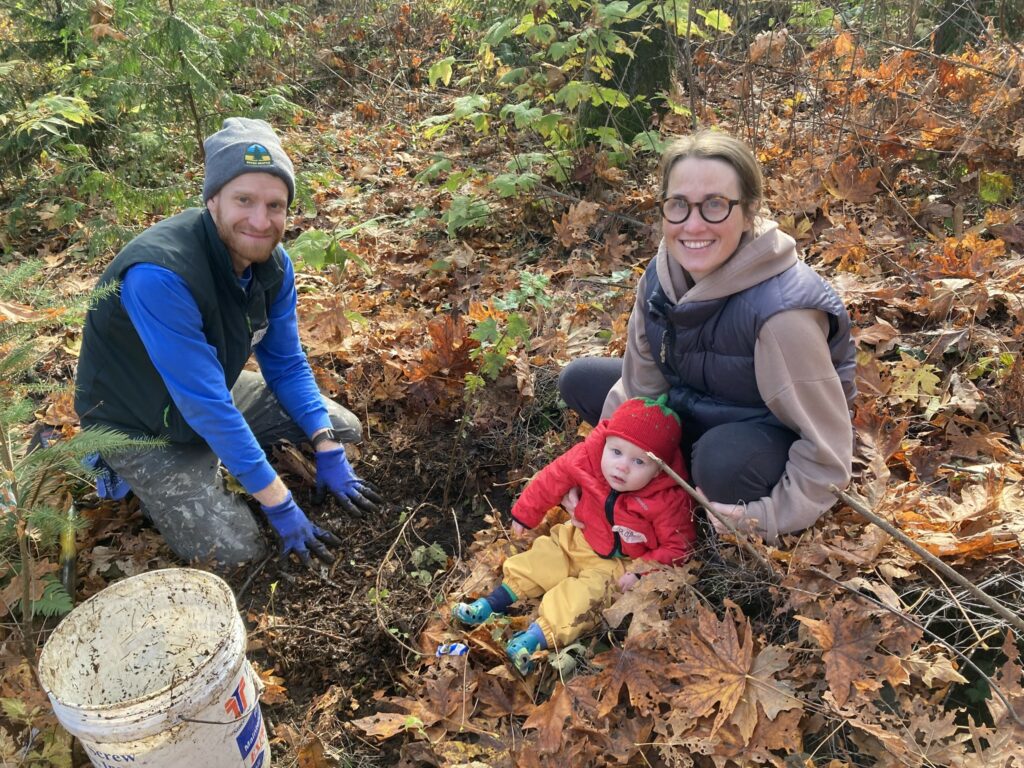
Ashley: Rain jackets and Waterproof boots are pretty essential! Staying dry is an important part of staying warm! Dress in layers in case things warm up or cool down. Bringing a change of clothes is always a good idea, being able to change into a dry sweater or socks if yours became wet can make a huge difference.
Long sleeves and long pants are always recommended in this type of work. A warm thermos of tea or hot chocolate can also be the warm treat you need out on a cold winter project! Check out @she_colorsnature who provides tips on what to wear for outdoor play.
Are there certain activities or items you recommend for little ones that attend but may not necessarily be participating?
Gerry: That would depend on the age of the kid. If they’re toddlers, they’re pretty happy just wobbling around and we have enough areas they can do that away from the street. Small kids can easily pull ivy and help their parents plant. By the time they’re in late elementary or junior high, I think they can do pretty much anything.
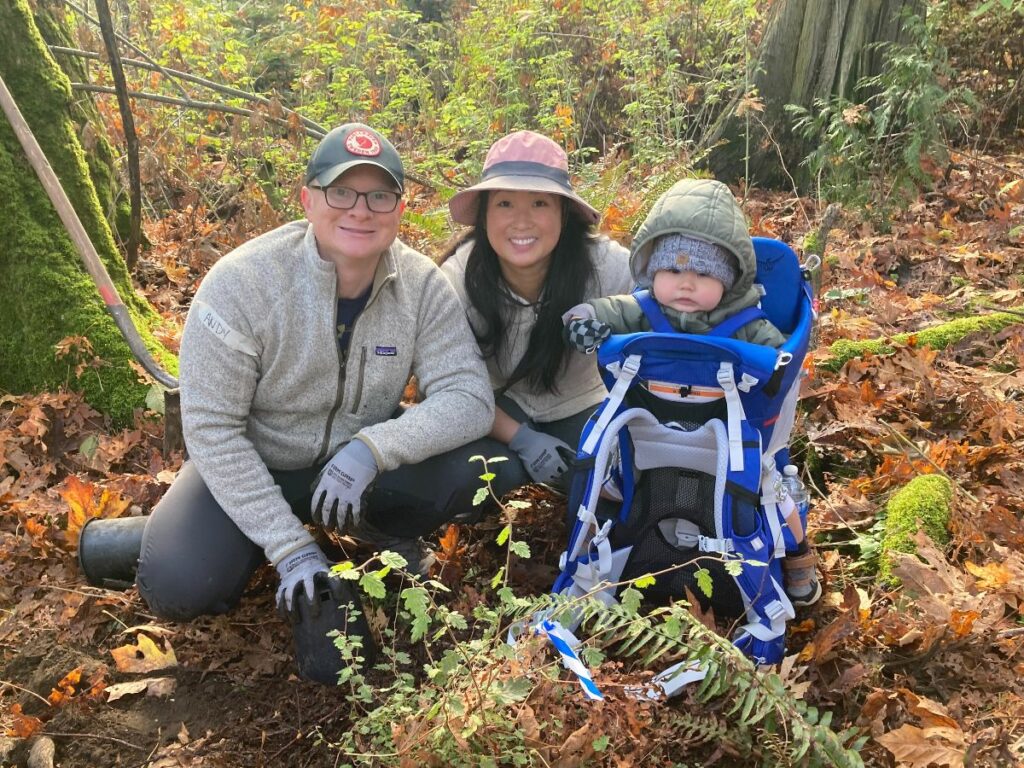
Ashley: You could wear kiddos in a backpack! Or plan to take turns with a partner watching after the little ones. Bring them things that will help them feel relaxed and keep them safe! As I mentioned earlier, bring books and toys that may provide alternative options to younger group members. Perhaps a camera so someone can help document the project. Perhaps a magnifying glass so someone can get a closer look at that bug or berry you just found!
In general, do you have any tips for families who are interested in getting their kids outdoors and active?
Gerry: As for tips, kids mimic their parents, and if their parents are having a good time, the kids will. When kids are old enough to work a bit more independently, it’s nice to separate them from their parents, so they have a chance to talk with other folks. In my opinion, relationships formed by working together in the outdoors are the best. At our regular November work party, renamed as Green Seattle Day Reprised, we had 2 babies in carriers watching our planting demonstrations, which I thought was very cool.
I also like to encourage people with connections to children to single out a tree when they plant it and somehow mark it–a ribbon or tie–and make it their kid’s special tree. Then they can come visit it and watch it grow, along with their child. I like to think that that gives them a special bond with the greenbelt as well as the joy of watching it grow along with them.
Ashley: Keep encouraging! Keep creating opportunities. Try out different things! Head toward what sticks! Talk about upcoming events amongst your community. Look for a variety of places to get involved – school, local park, local green belt, pea patch, farm, wetland, beachfront, there are so many exciting ways to get involved. Incorporate events and activities at Learning Centers, like Discovery Park Learning Center, Carkeek Enviornmental Learning Center and Seward Park Audubon. They all have fun programming geared toward kids. It’s a good opportunity to learn new ecological information and meet other kids interested in getting outdoors and active! Have fun!

Check out the homeschool stewardship squad, which participates frequently with GSP events.
A huge thank you to Gerry and Ashley for their wonderful insight on volunteering with kids! Interested in participating in an event? Join Gerry and our other forest stewards by keeping an eye out for a volunteer event near you on our CEDAR page.
